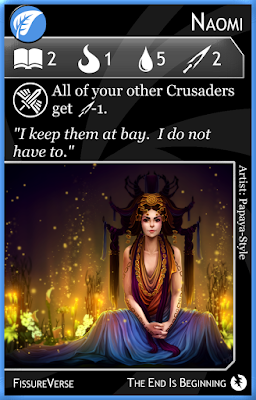Let's
start with the pretty splashy stuff: Location Cards have had their
layouts changed... in a big way.
 |
| New cards actually even bigger, I think. Not necessarily to scale. Click to embiggen. |
Now
don't get me wrong, I loved the old layouts. I would love to
use that layout again in another game. But they simply didn't fit
with the rest of the card layouts. These new layouts fit much
better, even if they lose that beautiful, seemingly borderless,
expansive design that works so well with landscapes.
One
major change that has occurred, however, is that the Location cards
are massively larger (perhaps obvious by the comparison above). Normal cards are 59x92mm, so old Location
cards were 92x59mm. However, why leave them the same size as normal
cards? They aren't going in a normal deck. So I doubled the size so
all players can more easily read the cards around the table. They
are now 184x118mm.
 |
| A couple more examples. |
Also a
new major change is that I'm done grinding my teeth about Spikers.
 |
| Spikers! |
Here
are what some Spikers look like.
Some
Spikers are location cards, just like any other card, with the
exception that they remain visible during the whole game (rather than
getting discarded). I expect other Spikers will have no Turn Order,
so they are flipped and a new card is immediately flipped after.
They might have special rules text like “All players immediately
gain a token.”
Also,
while I'm at it, I'm renamed Locations to the synonym Sites, because
“Locations” is a bit too polysyllabic and sterile, while “Sites”
give an almost reverential, religious feeling, as a game about
crusading should, or even archaeological feeling, which is also
acceptable.
Now
that the pretty pictures are over (you can see all of the new
location card layouts on the drive), the bigger change is the rules.
Like,
all of them.
Well,
there are enough major changes that the instructions need to be
completely rewritten.
I'm
still in the process of rewriting the instructions, but I thought I'd
post this for now, and upload the instructions at a later time to put
something on this blog (I know, it's been months).
Short
version of the new rules: Each player has their deck of Crusaders,
but the Frenzies and Rogations each get their own shared pile. You
are simply trying to rid a player of Crusaders, so there's no more
digging for Crusaders at the end; now it's obvious if there's any
Crusaders left because a player will have no Crusader draw pile, no
Crusader discard pile, no Crusaders in hand, and no Crusaders on the
Field.
Because
of this, the rules regarding enlisting need to be revised. On top of
that, I'm dividing the mechanics into sets, and seeing where things
land. Currently I feel like I only have three major mechanics going
on with Crusaders, which is hardly enough. On top of that, they're
simple mechanics, apart from some one-offs, so a lot needs to be
re-evaluated to make the game more interesting.
Instead
of building a deck outside of the game, card by card, players will
choose three sets they wish to play with. Each set is sixteen
Crusaders, eight Frenzies, and eight Rogations. The Frenzies and
Rogations all get shuffled together with other players' Frenzies and
Rogations into a single pile (well, a pile for Frenzies and a pile
for Rogations), and players can still play the Frenzies and Rogations
from other players' sets. There is now consistency in number of
Crusaders each player has, and the cards in any given set will work
well together, to provide interesting combos and mechanical choices,
while giving variety by having three sets to play with per player.
The interaction between sets for players to create and discover will
keep players coming back, especially as new sets come out.
This
is a massive shift, so tons of cards will be re-designed. Of course,
I won't be ditching any art or card names if I can help it, but
simple rules like “-1 Attack against Zealots, +1 Attack against
Devotees” will go away or be relegated to simple sets or split
loosely among many sets, while sets will mostly consist of more
interactive mechanics with fun decisions.
Also,
I'll be introducing Fetishes (the religious kind...), Gestalt cards,
and Reserve cards, all which will hang out outside the game until
certain conditions are met to bring them in.
More
to come...










